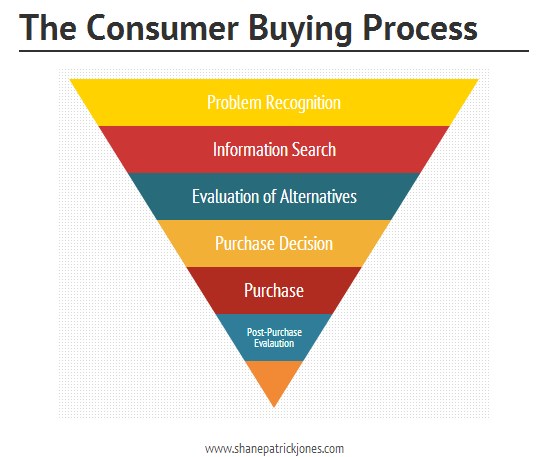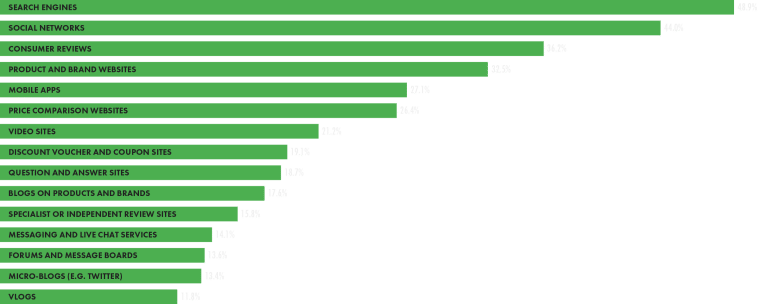Far too often, retailers think that consumer buying is randomized – that certain products appeal to certain customers and that a purchase either happens or it doesn’t – disregarding important marketing theory such as the 6 stages of the consumer buying process.
They approach product and service marketing in the same way, based on trial and error – casting their products and services into the lake and hoping to catch a bite.
Key Takeaways: The 6 Consumer Buying Process Stages
- Problem Recognition: Spark the buying process by highlighting a gap between the customer’s current state and a desired state, using content marketing to create awareness.
- Information Search: Position your brand as an industry leader to influence the customer’s search for solutions, leveraging SEO and social media marketing.
- Evaluation of Alternatives: Keep potential customers on your site for comparison, enhancing trust and simplifying their evaluation process.
- Purchase Decision: Reinforce the customer’s decision to proceed with targeted marketing, emphasizing the benefits of your product or service.
- Purchase: Ensure a smooth and simple purchase process, addressing any potential obstacles that could deter the final decision.
- Post-Purchase Evaluation: Follow up to confirm satisfaction, address any concerns, and foster loyalty, setting the stage for future purchases.
But what if there were a distinctive set of buying process steps that most consumers went through before deciding whether to make a purchase or not?
What if there was a scientific method for determining what goes into the buying process that could make marketing to a target audience more than a shot in the dark?
The 6 Stages of the Consumer Buying Process
The good news? Thanks to endless research by decades of academic marketing experts – the consumer buying process steps exists.
The actual purchase is just one step, in fact, when you analyse the steps taking by a customer in their purchase journey, there are six stages to the consumer buying process.
And as a marketer you can approach them all with strategic techniques and theory – enabling you to make the biggest impact with your marketing content.
So without further adjure, here are the six stages of the consumer buying process and the best way to approach each stage as a product or service marketer.
1. Problem Recognition
Put simply, before a purchase can ever take place, the customer must have a reason to believe that what they want, where they want to be or how they perceive themselves or a situation is different from where they actually are.
The desire is different from the reality – this presents a problem for the customer – however, for the marketer, this creates an opportunity.
By taking the time to “create a problem” for the customer, whether they recognize that it exists already or not, you’re starting the buying process.
To do this, start with content marketing: share facts and testimonials of what your product or service can provide.
Ask questions to pull the potential customer into the buying process, doing this helps a potential customer realize that they have a need that should and could be solved.
2. Information Search
Once a problem is recognized, the customer search process begins – here the customer knows there is an issue and they’re looking for a solution.
If it’s a new makeup foundation, they look for foundation; if it’s a new refrigerator with all the newest technology thrown in, they start looking at refrigerators – it’s fairly straight forward.
As a marketer, the best way to market to this need is to establish your brand or the brand of your clients as an industry leader or expert in a specific field.
Methods to consider include becoming a Google Trusted Store or by advertising partnerships and sponsors prominently on all web materials and collaterals
Becoming a Google Trusted Store, like CJ Pony Parts – a leading dealer of Ford Mustang parts – allows you to increase search rankings and to provide a sense of customer security by displaying your status on your website.
Another technique that is unmissable during the information search phase is SEO optimisation, which is critical for ensuring that the informational content you put out is seen.
Source / Social Media is the 2nd Most Popular Channel for Brand Research
This also extends to social media marketing – which acts as an additional and often highly persuasive channel of communication during the information search.
Increasing the credibility of your business, markets to the information search process by keeps you in front of the customer and ahead of the competition.
3. Evaluation of Alternatives
Just because you stand out among the competition doesn’t mean a customer will absolutely purchase your product or service.
In fact, now more than ever, customers want to be sure they’ve done thorough research prior to making a purchase, because of this, even though they may be sure of what they want, they’ll still want to compare other options to ensure their decision is the right one.
Marketing to this couldn’t be easier.
Keep them on your site for the evaluation of alternatives stage, for example leading insurance provider Geico allows customers to compare rates with other insurance providers all under their own website – even if the competition can offer a cheaper price.
This not only simplifies the process, it establishes a trusting customer relationship, especially during the evaluation of alternatives stage.
4. Purchase Decision
Somewhat surprisingly, the purchase decision falls near the middle of the six stages of buying process.
At this point, the customer has explored multiple options, they understand pricing and payment options and they are deciding whether to move forward with the purchase or not.
That’s right, at this point they could still decide to walk away – meaning marketing during this stage is critical for your business.
And this means it’s time to step up the game in the marketing process by providing a sense of security while reminding customers of why they wanted to make the purchase in the first time.
At this stage, giving as much information relating to the need that was created in step one along with why your brand, is the best provider to fulfil this need is essential.
If a customer walks away from the purchase, this is the time to bring them back.
Retargeting or simple email reminders that speak to the need for the product in question can enforce the purchase decision, even if the opportunity seems lost.
Step four is by far the most important one in the consumer buying process. This is where profits are either made or lost.
5. Purchase
A need has been created, research has been completed and the customer has decided to make a purchase – great – right?
After all, every stage that leads up to a conversion have been finished.
However, this doesn’t mean it’s a sure thing – the consumer could still be lost – therefore marketing is just as important during this stage as during the previous.
Marketing to this stage is straightforward: keep it simple.
Test your brand’s purchase process online – is it complicated? Are there too many steps? Is the load time too slow? Can a purchase be completed just as simply on a mobile device as on a desktop computer?
Ask these critical questions and make adjustments.
If the purchase process is too difficult, customers, and therefore revenue, can be easily lost.
You should also ensure that the customer is met with an acknowledgement email to confirm receipt of their order – this is a good opportunity to promote more about your products, services, and brand.
6. Post-Purchase Evaluation
Just because a purchase has been made, the process has not ended – in fact, newly won revenues and customer loyalty can be easily lost – there is still a final layer to the 6 stages of the consumer buying process.
After a purchase is made, it’s inevitable that the customer must decide whether they are satisfied with the decision that was made or not – they are in a process of evaluation that could have consequences for your business such as repeat purchases or reviews.
Worse still? If a customer feels as though an incorrect decision was made, a return could take place.
This can be mitigated by identifying the source of dissonance, and offering an exchange that is simple and straightforward.
However, even if the customer is satisfied with his or her decision to make the purchase, whether a future purchase is made from your brand is still in question.
Because of this, sending follow-up surveys and emails that thank the customer for making a purchase are critical for continued engagement and loyalty building.
Consumer Buying Process: The Bottom Line
Overall, you must take the time to understand the 6 stages of the consumer buying process.
Doing this ensures that your marketing strategy can be adjusted to ensure that it addresses each stage, and leads to higher conversion rates and long-term customer loyalty.
All of this is imperative for building out your well-oiled marketing machine.
References:
- Business2Community – Social Media Marketing Deep Dive
- Business2Community – Best Content Marketing Strategies
- Business2Community – Complex or Simple Buying Process
- Business2Community – Best SMS Marketing Software: 10 SMS Marketing Platforms
- Business2Community – Best Email Marketing Software – 10 Best Email Marketing Services for your Business
- Business2Community – How to Write an Acknowledgement Email
- Business2Community – SEO Guides
- Business2Community – Understanding The Customer Buying Cycle
- CopyPress – How to Create a Need in Content Marketing
- DataReport – Digital Marketing Global Snapshot 2023
- Geiko – Insurance Landing Page
- Indeed – Consumer Buying Process
- Google – Trusted Stores
- Stratton Craig – Content Marketing


